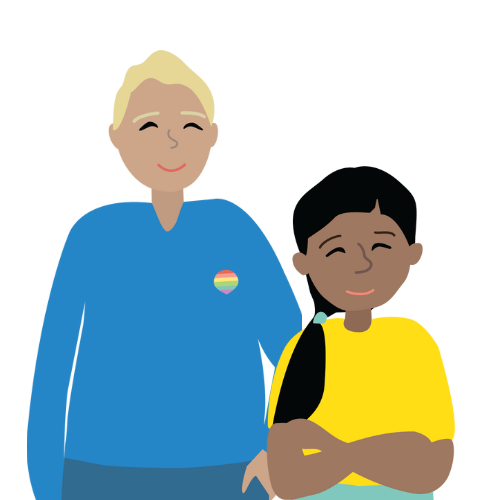
Chronic Pain
Overview
When a child or youth has chronic pain, their care should include a multimodal, biopsychosocial approach employing physical, psychological, occupational, and pharmacologic modalities*.
Guidelines on the management of chronic pain in children. Geneva: World Health Organization; 2020. License: CC BY-NC-SA 3.0 IGO.
The primary focus of treatment in chronic pain is functional improvement and pain reduction. Whenever possible, pharmacologic therapies should consist of non-opioid analgesia. For some types of chronic pain adding opioids may be necessary.
This toolkit section includes resources for managing children and youths’ chronic pain, including when and how to introduce opioids for specific chronic pain conditions in a safer manner.
When opioids are prescribed and administered for chronic pain, there are several considerations to ensure safer therapeutic use:
- Children and youth with chronic pain should receive an individualized and multidisciplinary approach to their care
- Physical (e.g., physical therapy) and psychological (e.g., biofeedback, distraction) treatments should be used for all children and youth with chronic pain
- Non-opioid medications can be considered as part of balanced multimodal pharmacotherapy to treat chronic pain in pediatric patients, simple analgesia (e.g., acetaminophen, NSAIDs), antidepressants, anticonvulsants, and topical treatments such as lidocaine patches
- Opioids are rarely prescribed for chronic pain in the pediatric population, due to the lack of evidence regarding its efficacy in chronic pain as well as their adverse effects profile
- For the rare circumstances when opioids are indicated for chronic pain, they should be trialed at the lowest effective dose, titrated over time, linked to improvements in function (not pain reduction alone), and used for the shortest period of time possible
- Opioids should be prescribed by a single healthcare professional with close monitoring and follow up
- Any healthcare professional overseeing the use of opioids for chronic pain should have the knowledge and skills to assess pain and function; appropriately prescribe, monitor, taper, and discontinue opioids; and recognize and treat opioid use disorder
- Children and their families should always be counselled about the potential side effects of opioid medications
- Potential risk for higher-risk opioid use should be assessed using a validated risk assessment tool before prescribing or administering opioid analgesia
- Children and youth who are prescribed opioids for chronic pain should be educated about the risks of physical and psychological dependence, as well as withdrawal
Opioids should be prescribed and administered in a culturally safe way.
Also consider risks for opioid use disorder, higher-risk opioid use, child age, and preexisting mental health diagnoses.
However, even when these risks are present, children with severe chronic pain have the right to adequate pain management, which may include the use of opioids. Children and their families should share the decision-making about whether opioid analgesia is appropriate for them with their healthcare provider.
Adverse childhood experiences (abuse, neglect, and household dysfunction occuring before the age of 18) have the potential to impact a youth’s perception and expression of pain, and its association with chronic pain.
If there is a need for long-term opioid use for chronic pain, establish a clear plan that identifies a single prescriber (only one person) and includes regular followup (monitoring symptoms and function), communication and record keeping.
Definition of chronic pain:
Pain that persists or recurs for longer than three months. The World Health Organization’s International Classification of Disease (ICD-11) considers chronic pain as a disease in its own right (i.e., chronic primary pain) or secondary to an underlying disease (i.e., chronic secondary pain). It can include chronic cancer-related pain, chronic neuropathic pain, chronic secondary visceral pain, chronic post-traumatic and post-surgical pain, chronic secondary headache and orofacial pain, and chronic secondary musculoskeletal pain. Children can experience acute and chronic pain concurrently.
CAN/HSO 13200:2023 Pediatric Pain Management Standard, 2023
“Chronic pain is a complex phenomenon which can have a devastating impact on the quality of life for children and youth, and their families. Health professionals can help young people with chronic pain find ways to cope with their symptoms and allow them to lead rich, meaningful lives. A holistic approach is essential to achieve these goals. Although opioids may be considered for some types of chronic pain in children, their role is limited due to their potential for harm, and limited efficacy in the setting of chronic pain. However, in rare situations when opioids are indicated for chronic pain, a trial of opioids should be considered only when a combination of nonopioid pharmacotherapy and physical and psychological strategies have provided inadequate symptom control.”
~ Dr. Marie-Joëlle Doré-Bergeron, Physician
Have feedback? Visit linktr.ee/youthinpain or kidsinpain.ca/youth-in-pain to learn more about this toolkit. For content suggestions please e-mail contact@kidsinpain.ca
References
Statements and Guidelines
Guidelines on the management of chronic pain in children
World Health Organization. 2020
View practice guideline
Opioid prescribing for chronic pain: care for people 15 years of age and older
Health Quality Ontario. 2018
View quality standard
Pharmacological Management of Chronic Neuropathic Pain: Revised Consensus Statement from the Canadian Pain Society
Moulin DE, et al. Pain Research Management. 2014
Access consensus statement
Review Articles
Pharmacological Interventions for Chronic Pain in Pediatric Patients: A Review of Guidelines
Canada’s Drug and Health Technology Agency. 2020
View guidelines
Management of chronic pain in children and young people: summary
Scottish government. 2018
Access article
Health Professional Resources
Pre-Surgical Screening Tools and Risk Factors for Chronic Post-Surgical Pain: A Summary
Canada’s Drug and Health Technology Agency. 2022.
This resource helps identify evidence-based risk factors and screening tools for chronic postsurgical pain, allowing for pain management to be planned and initiated before surgery and for more appropriate and timely pain management during the peri-surgical and post-surgical periods.
Access article
Canadian guideline for safe and effective use of opioids for chronic noncancer pain. Clinical summary for family physicians. Part 2: special populations
Kahan M, et al. Canadian Family Physician. 2011. Provides a practical clinical summary of the Canadian Guideline for Safe and Effective Use of Opioids for Chronic Non-Cancer Pain, developed by the National Opioid Use Guideline Group.
View practice guideline
Youth and Family Resources
Power Over Pain Portal for Youth
The Hospital for Sick Children. 2023 The Power Over Pain Portal provides youth with chronic pain access to a range of free resources, courses and peer support. The portal was codesigned by Canadian youth living with chronic pain.
Access Portal
Longer-lasting pain: how to treat and manage in infants and toddlers
About Kids Health. SickKids. 2019 Managing ongoing pain in infancy is vital for long-term outcomes; the 3P approach includes psychological, physical, and pharmacologic methods.
View website
Chronic pain: How to treat and manage in young children
About Kids Health. SickKids. 2019
Discover how to use the 3P approach to manage chronic pain in a young child.
Visit website
Chronic pain: How to treat and manage in older children
About Kids Health. SickKids. 2019
Find out how to use the 3P approach to manage chronic pain in older children.
Visit website
Chronic pain: How to treat and manage in teens
About Kids Health. SickKids. 2019
Find out how the 3P approach to pain management can help your teen manage their chronic pain.
Visit website
Additional Resources
Hydromorphone for cancer pain
Li Y, et al. Cochrane Database Systematic Review. 2021
Access article
Chronic pain: an update on burden, best practices, and new advances
Cohen S, et al. Lancet. 2021
Access article *subscription-based access
Pragmatic but flawed: the NICE guideline on chronic pain
Eccleston C, et al. Lancet. 2021
Access article *subscription-based access
Opioids for chronic non-cancer pain in children and adolescents
Cooper TE, et al. Cochrane Database Systematic Review. 2017
Access article
Opioids for cancer-related pain in children and adolescents
Wiffen, P., et al. Cochrane Database Systematic Review. 2017
Access article
Long-term neuropsychological effects of opioid use in children: a descriptive literature review
Mahendra V, et al. Pain Physician. 2014
Access article
Opioid tapering in children: a review of the literature
Fisher D. ACCN Advanced Critical Care. 2010
Access article *subscription-based access
Tolerance and Withdrawal From Prolonged Opioid Use in Critically Ill Children
Anand K.J.S., et al., Pediatrics. 2010
Access article
Production of this document has been made possible through a financial contribution from Health Canada. The views expressed herein do not necessarily represent the views of Health Canada.

.png)
